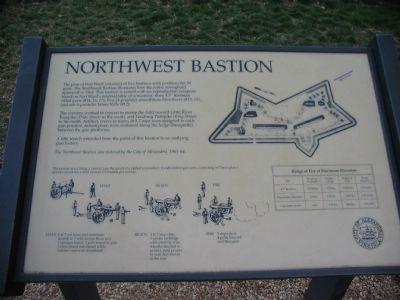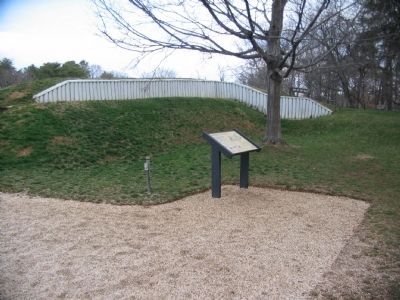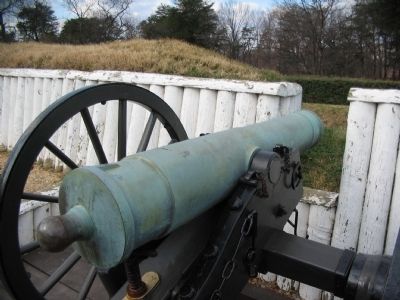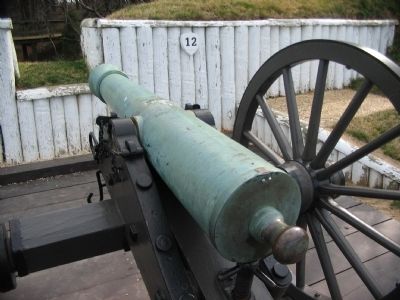Seminary Hill in Alexandria, Virginia — The American South (Mid-Atlantic)
Northwest Bastion
The cannons worked in concert to sweep the field toward Little River Turnpike (Duke Street) to the south, and Leesburg Turnpike (King Street) to the north. Artillery crews in teams of 5-7 men were assigned to each gun position. Infantrymen were stationed along the ledge (banquette) between the gun platforms.
A rifle trench extended from the point of this bastion to an outlying gun battery.
The Northwest Bastion was restored by the City of Alexandria, 1961-64.
Erected by City of Alexandria.
Topics and series. This historical marker is listed in these topic lists: Forts and Castles • War, US Civil. In addition, it is included in the Defenses of Washington series list. A significant historical year for this entry is 1864.
Location. 38° 49.847′ N, 77° 6.141′ W. Marker is in Alexandria, Virginia. It is in Seminary Hill. Marker is on West Braddock Road. Located in Fort Ward Historic Site. Touch for map. Marker is at or near this postal address: 4301 West Braddock Road, Alexandria VA 22304, United States of America. Touch for directions.
Other nearby markers. At least 8 other markers are within walking distance of this marker. Powder Magazine and Filling Room (a few steps from this marker); Profile of Fort (within shouting distance of this marker); Fort Ward (within shouting distance of this marker); Bombproof (within shouting distance of this marker); Jackson Cemetery (about 300 feet away, measured in a direct line); Rifle Trench (about 300 feet away); The Oakland Baptist Church (about 400 feet away); a different marker also named Fort Ward (about 500 feet away). Touch for a list and map of all markers in Alexandria.
More about this marker. On the lower half of the marker is a illustration of the operations of Civil War era artillery. Numbers reference the crew members manning the gun. The precise art of firing a cannon was the result of a skilled team effort. A well-drilled gun crew, consisting of 7 men plus gunner, could fire a field cannon 2-3 rounds per minute.
LOAD 6 & 7 cut fuses and distribute rounds to 5 who carries them to 2. 1 sponges barrel. 2 puts round in gun. 1 rams round into barrel while 3 closes vent with thumbstall.
READY 1 & 2 step clear. 3 pricks cartridge with priming wire. 4 hoods lanyard to primer, puts primer in vent and moves to the rear.
FIRE 3 steps clear. 4 pulls lanyard and fires gun.
An engineering plan of the fort on the upper right indicates the gun positions in blue. A blue line extending from the fort indicates the location of infantry trenches.
A chart on the lower right indicates Range of Fire at Maximum Elevation of the weapons in the bastion. A 4.5" Rodman weighed 9,700 lbs and fired a 25-30 lb. projectile with a 3.25 lb powder charge to a range of 1.75 miles. A 24-pounder Howitzer weighed 1,380 lbs and fired a 24 lb projectile with 2 lbs of powder to 0.75 miles. A 6-pdr James weighed 884 lbs and fired a 6 lb projectile with 1.25 lbs of powder to 1 mile.
Also see . . . Fort Ward Historic Site. (Submitted on May 15, 2008, by Craig Swain of Leesburg, Virginia.)
Additional commentary.
1. Rodman Gun
The 4.5-inch Siege Gun Model 1861 is often incorrectly, as is in this marker's text, attributed to the Army ordnance officer Thomas J. Rodman. Rodman is not known to have any direct connection to this weapon's design or construction.
— Submitted May 15, 2008, by Craig Swain of Leesburg, Virginia.
Credits. This page was last revised on January 27, 2023. It was originally submitted on May 15, 2008, by Craig Swain of Leesburg, Virginia. This page has been viewed 2,666 times since then and 31 times this year. Photos: 1, 2, 3, 4, 5, 6. submitted on May 15, 2008, by Craig Swain of Leesburg, Virginia.





